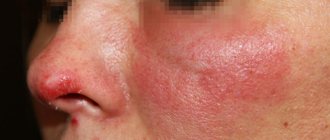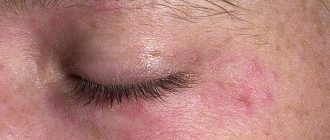Clothes are not only about fashion and convenience, but sometimes also about allergies. What causes allergies to clothes and how to counteract them?
Allergies to clothing usually manifest as contact dermatitis. Usually this is redness and irritation of the skin, rash, peeling, itching. In order not to confuse a skin reaction to clothing with other forms of allergies, you need to know that these symptoms most often occur under the knees, on the buttocks, in the groin, under the arms and in the crooks of the arms. Symptoms may worsen if your clothing rubs or you sweat a lot in hot weather. In areas where the skin is damaged, there is a risk of bacterial and fungal infections.
Allergic rhinitis from inhaling chemicals contained in clothing cannot be ruled out; Allergic conjunctivitis may also occur.
Sometimes the reaction occurs a few hours after contact with the allergen, sometimes after a few days.
Contact dermatitis caused by clothing is more common in women than men. Experts suggest that this is because women wear tighter-fitting clothes, which are also multi-colored, that is, made using dyes. People with atopic dermatitis and people with sensitive skin are more likely to develop clothing allergies. Another risk group is people who are overweight or obese, as well as those who work in hot and humid areas: in bakeries, in the kitchens of canteens and restaurants, in laundries, and in foundries. And of course, workers of textile enterprises.
Causes
Patients with allergies always have a hereditary predisposition to its occurrence. Among relatives there will definitely be allergy sufferers, and their allergies can manifest themselves in different ways: skin, food, allergic rhinitis, bronchial asthma - the form does not matter.
To develop the clinical picture, exposure to a sensitizing substance—an allergen—is necessary. They can be dust, pollen, chemicals in detergents, clothing, hazardous industries, some food products, medicines, etc., as well as substances formed in the body itself under the influence of cold or sunlight, metabolic products of parasites.
How do skin allergies develop?
An allergic reaction is a special form of response of our immune system to an allergen, in other words, a reaction of increased sensitivity of our body to any substance.
In the development of true allergies, there are 2 global concepts:
- Sensitization is when a person encounters an allergen for the first time, and it affects the body in small doses. So to speak, getting to know the allergen.
- The reaction itself is an allergy, accompanied by itching, redness of the skin and other manifestations.
Primary contact with an allergen gives a signal to the immune system to create special antibodies, which subsequently attach to mast cells and “sit” there. During sensitization, our body does not start a “war” against the allergen, it only remembers it, so allergy symptoms, such as spots on the skin, will not appear immediately.
⠀
But the next time there is contact between the incoming allergen and the antibodies already sitting on the cells, a cascade of reactions will occur with the release of certain substances (the main of which is histamine), and all this will cause allergy symptoms - itchy skin, etc.
⠀
This mechanism of allergy development is called an immediate reaction, and it occurs within 30–120 minutes. This type is characteristic of urticaria, allergic rhinitis, angioedema.
⠀
There is also a cell-mediated mechanism for the development of allergy, which is characteristic of gastroforms of allergy. In this case, the lymphocytes of our body do not create any special antibodies when exposed to an allergen, but release cytokines. In turn, cytokines activate other cells in our body, which form inflammation in the tissues.
But in chronic allergic dermatoses (eczema, atopic dermatitis), both mechanisms of allergy development may be present.
Symptoms
Depending on the clinical form, skin allergies manifest themselves in different ways.
Allergic contact dermatitis occurs in the area of skin contact with an allergen (cosmetics, detergents, clothing items), but the affected area does not have clear boundaries. The skin may turn red, become covered with blisters, scales, crack, and itch.
Atopic dermatitis looks almost the same, but occurs when the body is exposed to a general allergen, which means it is localized not at the point of contact, but in characteristic areas - the face, neck, area behind the ears, natural folds of the skin, armpits, elbows, popliteal cavities. There is definitely itching.
Hives are a rash of many small reddish blisters that can appear for hours or days, then disappear and migrate to different parts of the body. The rash is very itchy.
Quincke's edema is the most dangerous manifestation of skin allergies. It is swelling of the skin and subcutaneous tissue. Most often localized in the face and neck area, because... the subcutaneous tissue there is loose and can swell quickly. The danger lies in the possible complete occlusion of the respiratory tract. Occurs, as a rule, due to intravenous administration of the allergen or oral administration, as well as insect bites.
Eczema is a neuro-allergic disease that occurs when exposed to an allergen and a stressor. It can appear in different ways, most often as an itchy area of redness with many blisters, crusts, weeping or dryness.
Synthetic clothing: to wear or not
Just a few decades ago, it was generally accepted that wearing synthetic items was harmful to health, since the skin did not “breathe” in them. Preference should be given to clothes made from natural materials:
- flax;
- silks;
- cotton
In recent years, the situation has changed dramatically, as innovative synthetic materials that “breathe” and perfectly absorb moisture have appeared on sale. For example, membrane fabric from which clothing for sports activities is made.
But still, low-quality synthetic fabrics can harm your health. Let's look at some of them.
Clinical researches
The effectiveness, safety and tolerability of La-Cri products have been clinically proven. The products are recommended by the Union of Pediatricians of Russia. During clinical studies, specialists were able to record excellent results.
It has been proven that La-Cri diaper cream:
- creates a protective barrier on the skin;
- relieves redness and irritation;
- provides gentle skin care.
Sources:
- Molochkova Yulia Vladimirovna, Dermatology. Brief reference book, GEOTAR-Media, 2022.
- Baumann Leslie, Cosmetic Dermatology. Principles and practice, MEDpress-inform, 2016.
- Ratner Desiri, Avram M.R., Avram M.M., Procedures in Dermatology. Clinical cosmetology, GEOTAR-Media, 2022.
Mechanism of reaction development
An allergic reaction develops when immune cells perceive substances contained in clothing as foreign and dangerous. As a result, blood cells begin to produce protective antibodies, which spread throughout the body, including reaching skin cells. When antibodies and protective cells interact, histamine is released, which provokes allergy symptoms.
Diagnostics
But it happens the other way around - a person does not see allergies point-blank, not to mention manias and phobias. It’s just that an allergy to artificial clothing does not always manifest itself as severe itching and profuse dermatitis.
Sometimes these can be rare spots that itch slightly.
Occasionally a person sneezes, perceiving this as dust getting on the nasal mucous membranes or a minor cold. Everything would be fine, but if diagnosed untimely, the disease can develop from a temporary stage into a chronic one.
How to distinguish a true skin allergy from a pseudo-allergy?
If a child has already tried a certain product several times and has not had any reaction, then he does not have a true allergy to this product, and it makes no sense to put the child on a diet for skin allergies.
If parents notice a connection with the amount of product consumed and the skin reaction, then most likely we are talking about a pseudo-allergy, which depends on the dose. In this case, there is no need to exclude a specific product; it is worth reducing its amount in the diet for skin allergies to such doses that do not cause a reaction.
It is important that an allergic reaction occurs exclusively to protein, but only a pseudo-reaction occurs to carbohydrates. Therefore, there is no true allergy to sweets. If a mother notices the appearance of rashes after the child eats chocolate, then it is necessary to minimize its consumption, and not eliminate it altogether.
In any case, if certain rashes appear on a child’s skin, you should contact a dermatologist, and if there is a connection with specific allergens, contact an allergist.
Preventive measures
To prevent irritation from becoming chronic, it is necessary not only to successfully treat it, but also to prevent possible relapses. If you do not want to provoke new attacks of allergies to synthetic materials, give preference to cotton or linen items, as well as clothes made of silk.
First of all, this should be underwear and all products that have direct contact with the skin.
For washing, use only powders with a hypoallergenic composition.
An allergy to synthetics is not the most common type of negative reaction to an irritant. The symptoms of this disease are easily preventable and treatable, and provoking factors can be excluded at any time.
Choose clothes not only by beauty, but also by smell and color. Unnaturally saturated colors can cause an allergic reaction, as well as foreign odors.
Clothing made from synthetic fibers usually costs much less than natural items. Therefore, not everyone can afford to fill their entire wardrobe with cotton and silk outfits.
And I also want to wear bright clothes. To ensure that the variety in the closet does not lead to monotony in the body's reaction, replace at least the underwear that is adjacent to the body with natural material.
What is the fabric made of?
The composition of artificial matter includes synthetic fibers, which irritate the mucous membranes and skin.
The most common types of threads used when sewing synthetic clothing:
polyester is an elastic and soft, but not hygroscopic material; acetate is a fiber reproduced from cellulose acetate, pliable, capable of maintaining its shape for a long time; elastane is a flexible and resistant material that can, after stretching, take on its original presentation; acrylic is one of the products of the oil industry; durable and resistant, but poorly permeable to air and highly electrified; Lycra is a strong, dense and at the same time very elastic fiber; widely used in the production of products that fit tightly to the body; viscose is an artificial material whose properties are as close as possible to the properties of natural fabrics; It is made from wood cellulose and has good hygroscopicity.
The moderate use of each of these fabrics in the production of clothing is completely justified. And allergies to synthetics most often arise not from the materials themselves, but from chemical products that are actively used for dyeing, fixing color, increasing wear resistance, protecting against moths and other treatments.
Drug rash: treatment in children and adults
The first thing to do after the appearance of hives is to stop taking the drug that caused it. If therapy involves taking several medications at once (both for internal and external use), it is advisable to temporarily stop treatment as such. After the “culprit” of the rash is identified, the doctor will select a safer analogue of the drug for the patient, which will differ in composition.
Treatment for drug-induced hives usually involves taking antihistamines. They are necessary to reduce the intensity of skin itching and burning.
In some cases, it may be necessary to use local hormonal agents. However, you need to remember that such ointments and creams are characterized by a rather aggressive effect, so they should not be used unless necessary. This is especially true for the treatment of drug rashes in infants and older children.
An important role in the treatment of rashes is given to the intake of enterosorbents, which absorb harmful substances and remove them from the body.
During treatment, you must follow a diet and drink enough fluids. It is advisable to exclude spicy, fried, smoked and salty foods, simple carbohydrates, and sweets from the diet.
What does hypoallergenic fabric mean?
N
Don’t underestimate the quality of fabrics, because clothes are close to the child’s body.
Hypoallergenic materials are necessary for everyone, not only allergy sufferers and not only children, but also adults, especially for bedding and underwear. The most relevant and useful information for modern parents is in our newsletter.
We already have over 30,000 subscribers! Clothing can have a serious impact on the skin and the entire body. The most common human reaction to fabric is allergic dermatitis. Allergy is the inability of the human immune system to fight foreign agents. At risk are children whose bodies are in the process of adapting to the world around them.
There are two reasons for tissue intolerance: high sensitivity of the skin, which reacts to mechanical friction (for example, lint), and a reaction to the chemicals used in the production of the material (resins, fixatives, dyes).
The reaction to the tissue is most often manifested by changes in the skin: irritation, blisters, redness, itching. Some people may experience sneezing, nasal congestion, watery eyes, shortness of breath, and coughing. In severe cases, people who suffer from multiple allergens may develop anaphylactic shock.
Formaldehyde can be added to any fabric - toxins that affect the respiratory tract, skin, eyes, even the nervous system. They are usually found in paint or fittings. These substances are added to low-quality raw materials in order to improve their properties artificially. It is important to trust the manufacturer of clothing, especially children's clothing, to prevent contact with harmful chemicals. Often, a low-quality item can have an unpleasant, pungent odor.
Read the article “Formaldehyde: what to watch out for” on our blog and find out all about what these substances are and why they are harmful.
We can say that both natural and non-natural fabrics can cause negative reactions in the body. Naturalness/unnaturalness is not a defining sign of a material’s hypoallergenicity. Reactions to wool, fur, and linen are common.
Materials that require especially careful attention from allergy sufferers are wool. Few sheep wool producers comply with environmental safety rules. Although high-quality wool can also give an individual reaction. An allergic reaction can occur even to soft natural cotton materials: cotton is also treated with chemicals when grown. If the pre-treatment system is imperfect, these substances are not completely removed. And yet we can say that cotton is the most hypoallergenic; cotton is the gold standard in the production of children's clothing. It is soft and does not interfere with natural heat exchange. We are talking about Penier cotton - the best quality knitwear.
Textile production technologist Ekaterina Savushkina:
– Cotton fibers come in different lengths and, accordingly, quality.
The fabric made from the shortest fibers is called “Open End” (20-27 mm), from the medium ones – “Carde” or “Ring” (27-35 mm), and from the longest and strongest – “Penya”. “Penya” is made of thin, smooth and silky thread, it does not “cough”, it is durable and beautiful. Cotton "Penya"
(luxury class) has excellent properties: hygroscopic, breathable, tear-resistant, warm and hypoallergenic. It is this type of cotton fabric that can be said to be exemplary and does not give reactions in a child or adult.
Don’t assume that one type of truly eco-friendly fabric is very little. In fact, “Penya” is multifaceted. Luxury cotton spun into one thread is used to produce items for newborns, diapers, and underwear. This is cotton without additives, very durable. Double-strand cotton is definitely a staple in any wardrobe with a small amount of additives and is used when sewing casual clothes. Wool is often added to three-thread thread; thick tracksuits, pajamas, dressing gowns, and even outerwear are sewn.
In addition, “Penya” is divided into types: kulirka, suprem, footer, interlock, ribana, cash-corse, velor. Let's look at them.
|
|
|
|
|
|
|
Assol Kuzina, mother of Anfisa (3 years 8 months) and Arsenia (1 year 10 months):
– At 1.5 months, his armpits turned red, where his collarbone was - dots appeared, and the legs closer to the groin also appeared. It seemed to me that I was breathing heavily. I thought I had eaten a pomegranate (they said it would increase hemoglobin), and so it was sprinkled on it. Then I changed his clothes, and the rash went away as if it had never happened. Our pediatrician said it was probably the bodysuit. I didn't put that bodysuit on him anymore and he didn't get a rash.
Sometimes it can be difficult to understand that it is the tissue that is to blame for the body’s reactions. Pediatrician Inga Vasilets says that to find out, you need to conduct a kind of “experiment”: remove all things - redness due to allergic dermatitis should go away almost immediately.
Pediatrician Inga Vasilets:
– Symptoms appear the first or second time you use a new thing.
Rashes with this type of allergy do not appear on the entire body, but in places of close contact with the material. In infants, an allergy to fabric can be confused with diaper rash from tight clothing. There should be no crowding... Local treatment: anti-inflammatory ointment with depanthenol for skin reactions. If the signs are pronounced and there are symptoms of damage to the upper respiratory tract, then we use allergy medications, for children these are drops. Course admission. And, of course, such a thing is thrown into the trash. The culprit of the allergic reaction is not the fabric itself, but a low-quality dye or “improver” that retains the shape of the clothing. For children, especially the smallest ones, and allergy sufferers, it is best to buy things made from dim fabrics precisely because of the absence of toxic dyes.
Another tip for preventing allergies: wash and iron new things. This reduces the likelihood of skin irritation several times. We mean that other fabrics in the house should be environmentally friendly: bed linen, curtains, curtains, furniture upholstery. This means that they should not have a pronounced odor and should not stain.
When choosing an item in a store, first look at the labeling. It reflects the composition of the material and its properties. By carefully reading the tags, you will understand how many natural components the fabric has and what chemicals were used to improve its structure.
Pay attention to the inscriptions “Does not wrinkle”, “Keeps its shape perfectly”. They mean that special substances were used in the manufacture of the material. Allergy sufferers should avoid items made from fabrics with such markings. If wool, linen and cotton fabrics are not suitable, then think about bamboo or nettle. Products made from these plants are hypoallergenic and do not contain dust mites. They almost never cause reactions.
But they are also rare and more expensive. In addition, they are rarely used in the production of children's things. Pay attention to synthetic fabrics, many of which are hypoallergenic: denim, fleece, acrylic, polyacrylic, nylon. The advantage of synthetic fabric is that it is wrinkle-resistant and immune to deformation. Special chemicals that cause unpleasant symptoms are practically not used in their manufacture. Synthetic fabrics need to be washed frequently to maintain their hygiene.
Read the article "Take It Off Now" about artificial fabrics and find out which ones are safe for children.
What can you learn from labels on clothes on the Russian market?
- ✔ “Euroflower” and “Eco-tex” sign
denotes safe, high-quality industrial textiles; it is suitable for most people without any special skin problems.
✔ “100% organic cotton” and “Naturtextile” sign
(if there is a license number on the package) - these are things of the highest environmental quality, safe even in case of exacerbation of skin allergies, they can alleviate the condition of dermatitis.
Avoid purchasing items that have the following words on the label:
- ✘“Mercerized”, “Does not mat”
– treated with chemicals to provide smoothness, strength and shine. Not recommended for exacerbations of skin diseases.
✘“Easy to care”, “Does not require ironing”, “Resistant to machine wash”
– processed with artificial resins that contain formaldehyde.
✘“Chlorine bleached”
– can cause exacerbations of allergic dermatitis.
Quick registration Get 5% discount on your first order!
You can rest assured that Lucky Child uses the best quality raw materials in the production of children's clothing. We choose Peigne cotton, use only water-based prints and do not use formaldehyde. All Lucky Child children's clothing has quality certificates.
La-Cri products and their help in fighting rashes
In addition to medications prescribed by your doctor to treat drug rashes, you can use La Cree Cream for Sensitive Skin. Its use helps reduce the intensity of rashes, redness and skin itching. Due to the fact that the product contains such active ingredients as string, licorice, violet and walnut extracts, as well as panthenol and bisabolol, the cream has a pronounced anti-inflammatory, regenerating, antipruritic effect. Since La-Cree Cream for sensitive skin does not contain hormones, it can be used for a long time.











